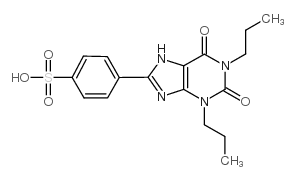Sustained reduction in myocardial reperfusion injury with an adenosine receptor antagonist: possible role of the neutrophil chemoattractant response.
M B Forman, J V Vitola, C E Velasco, J J Murray, R K Dubey, E K Jackson
Index: J. Pharmacol. Exp. Ther. 292(3) , 929-38, (2000)
Full Text: HTML
Abstract
Recent studies have demonstrated that three membrane-permeant A(1) receptor antagonists reduced infarct size in a model of ischemia followed by brief reperfusion. However, it was not determined whether cardioprotection was mediated by nonspecific intracellular effects of these highly lipophilic drugs and whether the antagonists only delayed myocardial necrosis without affecting the ultimate infarct size. In the present study, closed-chest dogs were subjected to 90 min of left anterior descending coronary artery occlusion and 72 h of reperfusion and received either a nonmembrane-permeant adenosine receptor blocker that is devoid of direct intracellular effects and is 6-fold selective for the A(1) receptor [1, 3-dipropyl-8-p-sulfophenylxanthine (DPSPX); n = 11] or vehicle (n = 12). DPSPX was administered as three 200-mg boluses 60 min before and 30 and 120 min after reperfusion. The area of necrosis was determined histologically and expressed as a percentage of the area at risk. Baseline predictors of infarct size were similar in the two groups. The ratio of the area of necrosis to the area at risk was less in the DPSPX group (17.8 +/- 4.3% versus 35.0 +/- 1.9%; P =. 012), and DPSPX improved regional ventricular function. Under both basal and stimulated (formyl-Met-Leu-Phe) conditions, suspensions of human neutrophils generated extracellular adenosine levels (approximately 50 nM) sufficient to activate A(1) receptors. Moreover, both DPSPX and 1,3-dipropyl-8-cyclopentylxanthine, a selective A(1) receptor antagonist, significantly reduced the chemoattractant response of neutrophils to formyl-Met-Leu-Phe. We conclude that blockade of A(1) adenosine receptors attenuates myocardial ischemic/reperfusion injury, possibly in part by decreasing the chemoattractant response of neutrophils.
Related Compounds
| Structure | Name/CAS No. | Molecular Formula | Articles |
|---|---|---|---|
 |
1,3-DIPROPYL-8-P-SULFOPHENYLXANTHINE
CAS:89073-57-4 |
C17H20N4O5S |
|
Extracellular 2',3'-cAMP-adenosine pathway in proximal tubul...
2013-01-01 [Am. J. Physiol. Renal Physiol. 304(1) , F49-55, (2013)] |
|
Expression of the 2',3'-cAMP-adenosine pathway in astrocytes...
2011-09-01 [J. Neurochem. 118 , 979-987, (2011)] |
|
Interaction of carbon monoxide and adenosine in the nucleus ...
2003-09-01 [Hypertension 42(3) , 380-5, (2003)] |
|
Angiotensin converting enzyme inhibition prevents trophic an...
2002-04-19 [Eur. J. Pharmacol. 441(1-2) , 99-104, (2002)] |
|
The role of angiotensin II in hypertension due to adenosine ...
2002-11-29 [Eur. J. Pharmacol. 455(2-3) , 135-41, (2002)] |